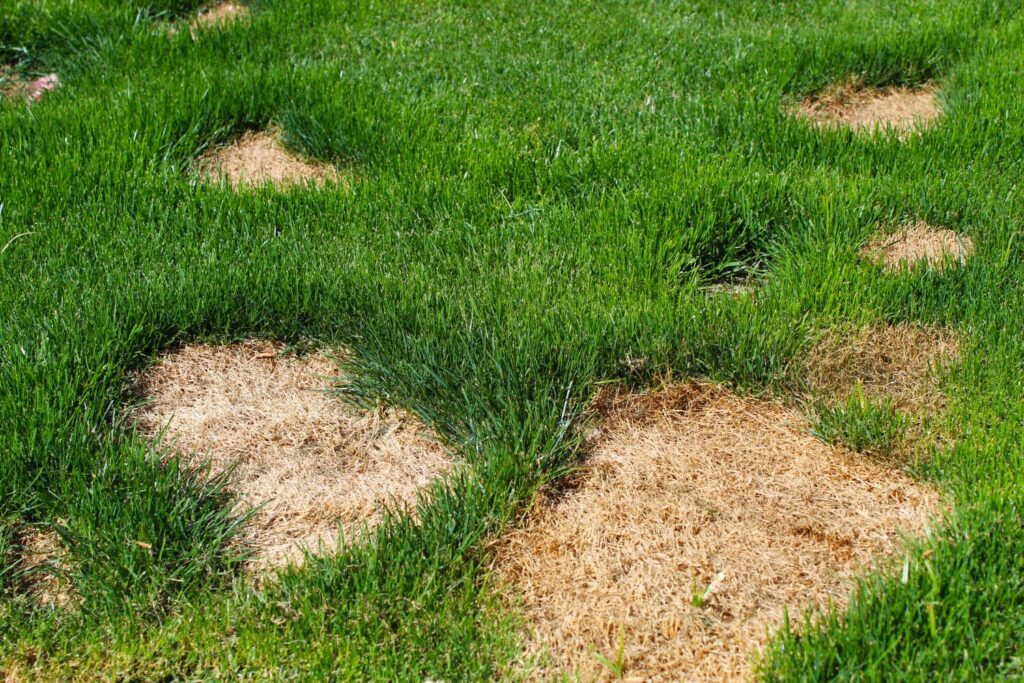
If you’re a dog owner, you’ve likely noticed unsightly brown patches on your lawn caused by your furry friend’s bathroom habits. Dog urine can scorch lawn grasses, leading to an
unattractive lawn with unhealthy patches or even areas that are completely dead.
Understanding the science behind this issue and implementing proven strategies can help
keep your lawn looking lush and green. Be warned however, if your dog pees on the lawn
then you are unlikely to avoid damage completely.
Understanding the Science Behind Dog Urine Damage
Dog urine contains high concentrations of nitrogen and is naturally acidic. While nitrogen is
an essential nutrient for grass growth, too much of it can cause damage. The high nitrogen
levels in dog urine essentially “burn” the grass, creating those telltale brown spots surrounded by lush, green grass where the nitrogen is less concentrated and benefits healthy grass growth. The acidic nature of urine can also alter the pH balance of the soil, further contributing to the damage.

Are Bitches More Likely to Cause Urine Damage to Lawns?
Interestingly, bitches (female dogs) are often more likely to cause noticeable lawn damage than male dogs. This is primarily due to the way they urinate. Bitches tend to squat and urinate in one concentrated spot, which delivers a higher dose of nitrogen to a small area of grass, causing more severe burn marks. In contrast, male dogs typically lift their leg and spray urine over a larger area, which dilutes the impact on any single spot. Understanding this behaviour can help in managing and mitigating lawn damage effectively.
Preventative Measures
Training Your Dog
• Designated Potty Areas: Train your dog to use a specific area of your garden for urination. This confines the damage to one spot and makes it easier to manage. There’s plenty of advice online about dog training which may help you.
• Use Mulch or Gravel: Designate areas with mulch or gravel for your dog to urinate. Take your dog to this area first thing in the morning when urine is likely to be more concentrated. These surfaces are not affected by urine in the same way as grass and can help prevent unsightly damage.
Lawn Care Practices
• Regular Watering: Water your lawn frequently to dilute the concentration of nitrogen. This helps prevent the urine from burning the grass. Focus on the areas where your dog tends to urinate the most.
• Lawn-friendly Fertilisers: Use fertilisers with balanced nitrogen content as when your lawn is receiving the correct nutrition you are less likely to notice the green halo around the urine damaged area.
Remedies for Existing Damage
Dilution Methods
• Immediate Watering: After your dog urinates, water the area immediately to dilute the urine and reduce its impact on the grass. This quick action can significantly minimise damage. It’s unlikely you can do this every time your dog uses your lawn as a toilet but get in the habit first thig in the morning and that may help.
Reseeding and Patch Repair
• Using Urine-resistant Grass Varieties: Consider reseeding damaged areas with more resilient grass types such as fescue or perennial ryegrass. These grasses are sometimes more tolerant of higher nitrogen levels and can recover more quickly from damage.
• Patch Repair with Plant Pots: For a more immediate solution, grow replacement grass patches in plant pots. Trim the tops regularly to create little circles of turf. Once the grass is established, remove the damaged turf and replace it with the pre-grown patches. This method ensures a quicker recovery and a more seamless appearance. Simply prepare the damaged area by removing the dead grass, level the soil, and then transplant the grass from the pots into the bare spots.
Conclusion
Dog urine damage in gardens can be a frustrating issue, but with the right knowledge and techniques, you can manage and even prevent it. By understanding the science behind the damage and implementing preventative measures and remedies, you can keep your garden looking its best. Training your dog, adjusting your lawn care practices, and choosing resilient grass types can all contribute to a healthier lawn.

 Established 2016
Established 2016



